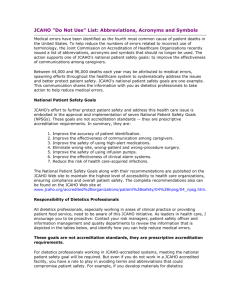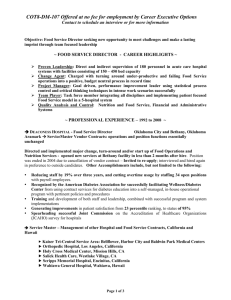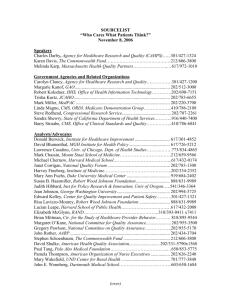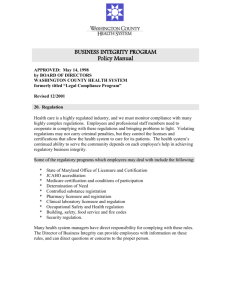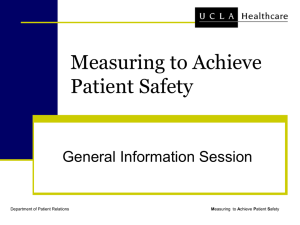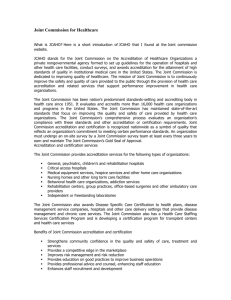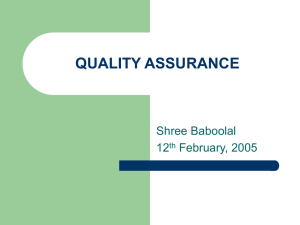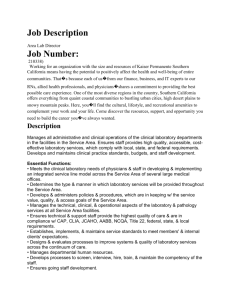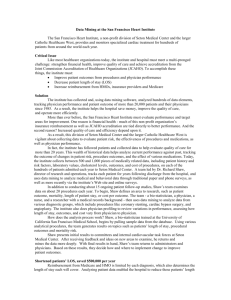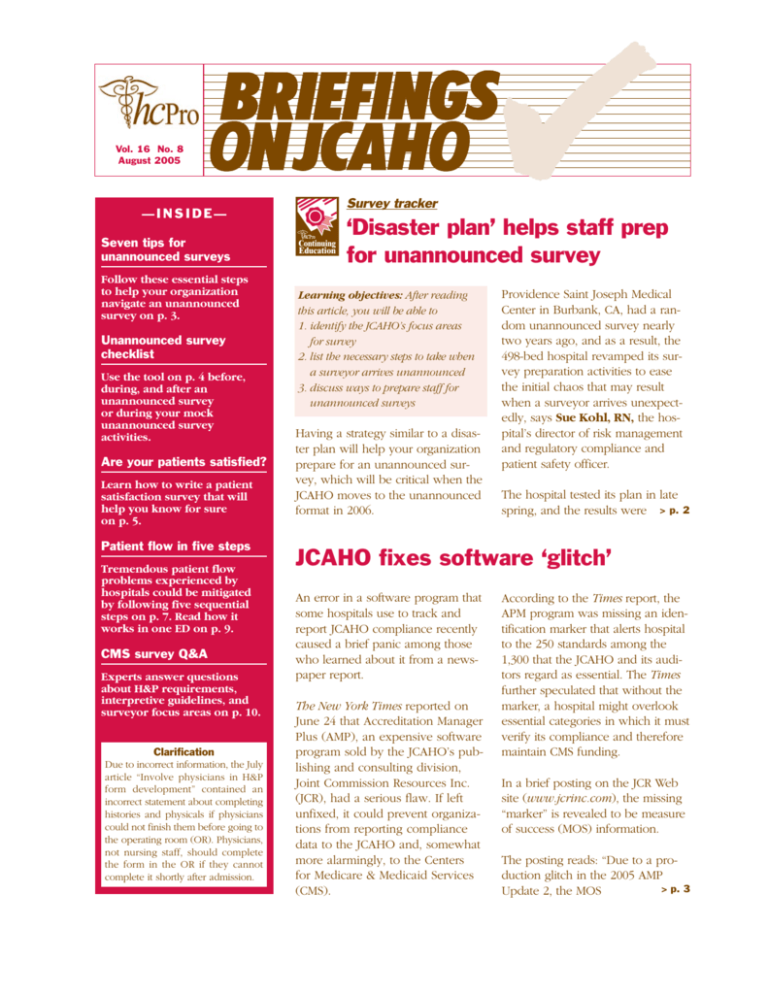
Vol. 16 No. 8
August 2005
Survey tracker
—INSIDE—
Seven tips for
unannounced surveys
Follow these essential steps
to help your organization
navigate an unannounced
survey on p. 3.
Unannounced survey
checklist
Use the tool on p. 4 before,
during, and after an
unannounced survey
or during your mock
unannounced survey
activities.
Are your patients satisfied?
Learn how to write a patient
satisfaction survey that will
help you know for sure
on p. 5.
Patient flow in five steps
Tremendous patient flow
problems experienced by
hospitals could be mitigated
by following five sequential
steps on p. 7. Read how it
works in one ED on p. 9.
CMS survey Q&A
Experts answer questions
about H&P requirements,
interpretive guidelines, and
surveyor focus areas on p. 10.
Clarification
Due to incorrect information, the July
article “Involve physicians in H&P
form development” contained an
incorrect statement about completing
histories and physicals if physicians
could not finish them before going to
the operating room (OR). Physicians,
not nursing staff, should complete
the form in the OR if they cannot
complete it shortly after admission.
Continuing
Education
‘Disaster plan’ helps staff prep
for unannounced survey
Learning objectives: After reading
this article, you will be able to
1. identify the JCAHO’s focus areas
for survey
2. list the necessary steps to take when
a surveyor arrives unannounced
3. discuss ways to prepare staff for
unannounced surveys
Having a strategy similar to a disaster plan will help your organization
prepare for an unannounced survey, which will be critical when the
JCAHO moves to the unannounced
format in 2006.
Providence Saint Joseph Medical
Center in Burbank, CA, had a random unannounced survey nearly
two years ago, and as a result, the
498-bed hospital revamped its survey preparation activities to ease
the initial chaos that may result
when a surveyor arrives unexpectedly, says Sue Kohl, RN, the hospital’s director of risk management
and regulatory compliance and
patient safety officer.
The hospital tested its plan in late
spring, and the results were > p.
2
JCAHO fixes software ‘glitch’
An error in a software program that
some hospitals use to track and
report JCAHO compliance recently
caused a brief panic among those
who learned about it from a newspaper report.
The New York Times reported on
June 24 that Accreditation Manager
Plus (AMP), an expensive software
program sold by the JCAHO’s publishing and consulting division,
Joint Commission Resources Inc.
(JCR), had a serious flaw. If left
unfixed, it could prevent organizations from reporting compliance
data to the JCAHO and, somewhat
more alarmingly, to the Centers
for Medicare & Medicaid Services
(CMS).
According to the Times report, the
APM program was missing an identification marker that alerts hospital
to the 250 standards among the
1,300 that the JCAHO and its auditors regard as essential. The Times
further speculated that without the
marker, a hospital might overlook
essential categories in which it must
verify its compliance and therefore
maintain CMS funding.
In a brief posting on the JCR Web
site (www.jcrinc.com), the missing
“marker” is revealed to be measure
of success (MOS) information.
The posting reads: “Due to a production glitch in the 2005 AMP
> p. 3
Update 2, the MOS
www.hcpro.com
Unannounced survey
< p. 1
impressive.
“Amazingly, it worked beautifully,” Kohl says. “[An
unannounced survey] tends to put an organization
into momentary chaos, wondering what [surveyors]
are going to look at, what they are going to need.”
‘Code Survey’
The hospital’s plan goes into effect as soon as surveyors identify themselves, Kohl says. Someone pages
“Code Survey,” notifying key departments and officials, such as the chief executive officer, nursing director, quality officials, and JCAHO compliance officials.
Within an hour of the surveyors’ arrival, staff locate a
meeting room for the command center. Any meetings
scheduled for that room will be moved or cancelled,
Kohl says.
The best rooms are large and have computer and
phone access, which is important for surveyors because they can communicate with the JCAHO office
in Illinois, Kohl says.
The food service director at Providence Saint Joseph is
responsible for the main calendar, so he knows which
rooms would be available on survey day, Kohl says.
The hospital also established a phone tree to notify
key people who would need to be in attendance if
they are not on site, Kohl says.
Establish a comfort level
Tip: Identify a backup person to fill in for the JCAHO
compliance officer or other key officials who can step
in should a surveyor arrive and those officials are out
of the office.
“You need to get staff very comfortable to answer
questions,” Kohl says. “Staff become very nervous
when a surveyor is asking them questions.”
Know your documents
The hospital segregated key documents, policies, and
procedures into notebooks so staff would be able to
locate them and deliver them to surveyors if requested, Kohl says. She timed how long it took staff to
locate documents during the test run, and the process
expedited the search for policies.
“It took no time at all because the documents were in
a binder already,” Kohl says.
National Patient Safety Goals will be a surveyor focus
this year, as will the priority focus areas: infection
control, patient safety, and assessment and care, says
Elizabeth Di Giacomo-Geffers, RN, MPH, CNAA,
BC, a healthcare consultant in Trabuco Canyon, CA.
Find a command center
When “Code Survey” is called, staff involved in the
survey know to head to a command center, Kohl
says. All survey operations take place out of that one
room, she says.
To train staff for survey, Providence Saint Joseph uses
tracer drills every two to three weeks, Kohl says.
To achieve a comfort level, “chapter chairs,” or
department managers responsible for a chapter of
JCAHO standards, received a one-hour training session on how to run a tracer before conducting a
mock tracer on the units, Kohl says.
Kohl developed a scorecard to show each unit how it
performs regarding JCAHO compliance and what it
can do to improve, she says.
Expect the unexpected . . .
Join HCPro live for Unannounced Survey:
Tips to Prepare, Train, and React to Surprise
Surveys, an August 18 audioconference.
Your peers—who have survived both JCAHO
and CMS unannounced surveys—share tips and
strategies to train staff along with valuable insight
into what to expect on actual survey day.
To register or purchase the tape, call 800/650-6787
and mention your source code NEWSAD.
For permission to reproduce part or all of this newsletter for external distribution or use in educational packets,
please contact the Copyright Clearance Center at www.copyright.com or 978/750-8400.
Page 2
© 2005 HCPro, Inc.
Briefings on JCAHO—August 2005
www.hcpro.com
Follow these seven unannounced survey tips
The following tips, provided by Elizabeth Di
Giacomo-Geffers, RN, MPH, CNAA, BC, a healthcare consultant in Trabuco Canyon, CA, will help a
hospital during an unannounced survey:
1. Surveyors typically arrive between 8:00 and 8:30
a.m. Ask to see their identification, notify the chief
executive officer (CEO), and escort the surveyors
to the CEO or a designated second in command.
Never leave surveyors unattended.
4. Appoint a senior leader to serve as an ambassador
to follow the surveyor. Pairing a senior leader with
a surveyor shows the JCAHO that executives take
pride in the care the hospital gives.
5. Have a scribe take notes on the survey and what
information the surveyor will look for. This person
should be someone who can multitask and who
understands the survey process, such as a quality
manager or JCAHO coordinator.
2. Make sure the CEO or designee asks to see a letter
signed by a JCAHO executive that explains the surveyors’ purpose for the visit.
6. Have a runner, or someone who can quickly grab
a policy or chart if the surveyor requests it.
3. Call a designated code so everyone knows to
assemble in a “command center.” Have a room for
the surveyors to use that includes telephone access,
photocopiers, and sufficient outlets for their computer and Internet access.
7. Keep track of every medical record the surveyor
uses in tracer activities and all human resource and
medical staff files reviewed. This will enable the
organization to accurately review any issues that
may arise during or after survey.
Glitch
< p. 1
designations are not appearing in the AMP tool after
the Update 2 Migration Wizard is performed.”
of the problem, says JCAHO spokesperson Mark
Forstneger.
AMP users are directed to download and run a software patch available at this address: www.jcrinc.com/
publications.asp?durki=10257.
Because of the glitch, the JCAHO suspended PPR uploads, thus disabling the function, on AMP in June.
The JCAHO directed organizations with June PPR due
dates to call their account representatives to seek a
30-day extension.
An initial site license purchase of AMP costs $3,595,
according to the JCR Web site. One of the capabilities
of the program allows users to upload data, such as a
completed periodic performance review (PPR), to
Jayco™, the JCAHO’s extranet site. Use of the program is not required for JCAHO accreditation.
Statistics were not available from the JCAHO on how
many organizations were affected, although it is believed that about 1,000 hospitals and more than 450
outpatient facilities, behavioral health facilities, home
health agencies, and nursing homes could be affected.
No customers lost any information or data as a result
One source close to the JCAHO believes that the AMP
problem may have been discovered shortly after the
release of the last update, which is delivered to subscribers on CD-ROM, and that the accreditor was
waiting until a future update to offer a fix.
The source believes the Times article put pressure on
the JCAHO to expedite a solution.
JCR sent Update 2 to subscribers in late May, and
the glitch was discovered in mid-June, Forstneger
says.
For permission to reproduce part or all of this newsletter for external distribution or use in educational packets,
please contact the Copyright Clearance Center at www.copyright.com or 978/750-8400.
Briefings on JCAHO—August 2005
© 2005 HCPro, Inc.
Page 3
www.hcpro.com
Sample unannounced survey checklist
Early survey activities
Completed?
Comments
Surveyors arrive on campus and proceed to administration
Escort surveyors to predetermined conference room
Immediately notify survey coordinator(s) of JCAHO arrival
Surveyors meet and greet administration
Review the agenda and required documentation with administrator and
survey coordinator
Send out organizationwide notice that surveyors are on campus and include the
type and focus of survey
Notify leadership of times for scheduled interview sessions and secure conference
rooms for interviews
Provide active daily census listing when requested
Provide surgical schedule when requested
Provide list of units, surgical suites, and postanesthesia care unit beds when requested
Provide current roster of physicians when requested
Provide survey ambassadors, scribes, and runners with department head list and
contact phone numbers
Provide scribes with notepads and pens/pencils
Provide runners with list of requested documentation
During the survey
Pair survey ambassadors with surveyors
Pair a scribe with each survey ambassador
Assist runners in locating requested documentation, if needed
Send scouts out to the next unit to look for and correct obvious deficiencies
Communicate frequently with organizational leaders on outcomes of survey activities
Debrief survey participants and organizational leaders at the end of each survey day
about the findings of survey activities
After the survey
Hold a closing conference with actual findings to administrator and senior leadership
Briefly summarize survey findings to staff
Celebrate survey successes
Begin action planning to address required improvements
Source: Adapted from a tool provided in the HCPro book Unannounced Survey: Frontline Strategies to Prepare
Your Organization for Surprise Surveys, written by Missi Halvorsen, RN, BSN.
For permission to reproduce part or all of this newsletter for external distribution or use in educational packets,
please contact the Copyright Clearance Center at www.copyright.com or 978/750-8400.
Page 4
© 2005 HCPro, Inc.
Briefings on JCAHO—August 2005
www.hcpro.com
Hospitals get satisfaction through patient surveys
Meet JCAHO requirements, obtain picture of quality via questionnaires
Continuing
Education
Learning objectives: After reading this article, you will be
able to
1. identify ways to use results from patient satisfaction
surveys
2. explain the importance of patient satisfaction surveys
3. recognize JCAHO standards related to patient
satisfaction
Keep your hospital’s patient satisfaction survey concise and to the point. This strategy will help keep
the patient’s attention when taking the survey and
help the organization obtain more meaningful
responses.
Ideally, the entire questionnaire should be 15 questions, says John Rosing, MHA, FAHCE, practice
director of accreditation and regulatory compliance
services for The Greeley Company, the Marblehead,
MA–based division of HCPro, Inc., which publishes
this newsletter.
If the hospital conducts a phone interview, it should
last no longer than four minutes, Rosing says. If the
interview is longer than that, the organization risks
losing the patient’s attention when taking the survey,
Rosing says.
“The shorter the better,” Rosing says. “It’s up to the
organization to determine what its needs and expectations are [when creating survey questions].”
Go above JCAHO requirements
Standard PI.1.10, element of performance (EP) 3, requires hospitals to collect data on patients’ perception
of care, treatment, and services provided, including
specific needs and expectations, how well the hospital
met those needs, how the hospital can improve safety,
and the effectiveness of pain management.
The JCAHO is moving from using the word “satisfaction” to “perception of care, treatment, and services,”
which allows the organization to assess patients’ satisfaction with care but also whether the organization
met their needs and expectations, according to the
Comprehensive Accreditation Manual for Hospitals.
Although the JCAHO only outlines four areas for hospitals to collect satisfaction data, organizations should
add more, Rosing says, including the following:
Wait times
Communication
Comfort, including room temperature, noise, and
distractions
Staff attention to a patient’s needs
Fairlawn Rehabilitation Hospital in Worcester, MA,
asks questions about admissions and registration procedures, nursing care, pain management, physicians,
food and facilities, discharge, and overall satisfaction,
says Patricia Garvey, MSN, RN, director of quality
management and education.
Present info to the board
Garvey presents information gleaned from survey
results to the hospital board of trustees each quarter.
Garvey’s “quality grid,” or scorecard, allows the board
to measure Fairlawn’s success and performance
against other HealthSouth rehab facilities, she says.
Fairlawn is owned by HealthSouth.
“You also can see any statistically significant changes
in data,” Garvey says.
The board takes particular interest in questions such as
a patient’s “likelihood to recommend the facility to others,” Garvey says. Most of the time, Fairlawn meets or
exceeds other organizations’ results, she says.
Use the results
Garvey distributes survey results to directors responsible for various departments at the hospital, she says.
If the results fail to meet those of other HealthSouth
facilities, she asks for a corrective action plan.
For example, scores were consistently low in food services at one point, Garvey says, partly because the
kitchen had flooded and cafeteria workers had to cook
> p. 6
out of a mobile trailer. Some patients
For permission to reproduce part or all of this newsletter for external distribution or use in educational packets,
please contact the Copyright Clearance Center at www.copyright.com or 978/750-8400.
Briefings on JCAHO—August 2005
© 2005 HCPro, Inc.
Page 5
www.hcpro.com
Patient surveys
< p. 5
complained on the survey, and the hospital changed its
coffee vendor for better quality and service, she says.
known for its Gallup Poll on public opinion, has a
healthcare division, Rosing says.
Another example involves the timeliness of physician
response, Garvey says. She brought survey results
concerning that issue to the physician group, who
developed an action plan to improve response times,
she says.
Hospitals may struggle to write their own surveys,
Garvey says.
Garvey also uses the results to let staff know patients
have a positive perception of care, she says.
“They’re hard to write and have them valid and tested,” Garvey says. “For us and most organizations, I
think it’s worth the commitment of money [to use a
vendor] because it’s valid and reliable.”
Satisfaction goes national
“You can give staff a pat on the back,” Garvey says.
Garvey also looks at any handwritten comments from
patients. Sometimes they are as simple as “everyone
was wonderful,” but sometimes patients ask for a
phone call to talk about their concerns, and Garvey
obliges, she says.
Management should be interested
The medical staff also have a regulatory interest in
patient satisfaction. JCAHO standard MS.2.10, EP 5
requires medical staff to provide oversight in the process of analyzing and improving patient satisfaction.
Senior management should review and evaluate results from satisfaction surveys, Rosing says. Leaders
need to assess the results and then determine what
changes should be made in the context of the organization’s current climate.
“They have to look at [results] wisely,” Rosing says.
“They can’t leap to conclusions.”
The Centers for Medicare & Medicaid Services is planning its own patient satisfaction survey, known as
HCAHPS. The 27-question survey includes questions
about communication with physicians and nurses,
pain control, staff responsiveness, and discharge
information.
The survey will supplement existing questionnaires
already in use at hospitals, and Medicare will be able
to collect standardized data on patient perceptions to
post on its Web site, www.medicare.gov.
Medicare anticipates beginning a test run of the survey
this summer, with a nationwide implementation in
early 2006. Go to www.cms.hhs.gov/quality/hospital/
to view the survey.
Patient satisfaction
survey companies
The following companies provide services to help
hospitals conduct patient satisfaction surveys:
Survey help exists
Using an outside vendor to conduct the survey and
compile the results gives hospitals the added bonus of
having benchmarks against other organizations,
Rosing says. Fairlawn uses NRC+Picker, a Lincoln,
NE–based research company, to conduct its surveys.
The Gallup Organization: www.gallup.com
Press Ganey Associates, Inc., of South Bend, IN, is
another company that provides survey services, and
The Gallup Organization of Princeton, NJ, widely
Professional Research Consultants: www.prconline.
com
NRC+Picker: http://nrcpicker.com/
Press Ganey Associates, Inc.: www.pressganey.com
For permission to reproduce part or all of this newsletter for external distribution or use in educational packets,
please contact the Copyright Clearance Center at www.copyright.com or 978/750-8400.
Page 6
© 2005 HCPro, Inc.
Briefings on JCAHO—August 2005
www.hcpro.com
Manage patient flow in five sequential steps
Leadership plays a key role in establishing goals
Continuing
Education
Learning objectives: After reading this story, you will be
able to
1. list five ways to improve patient flow
2. describe the JCAHO’s patient flow standard, LD.3.15
Hospitals continue to struggle with patient flow in
their emergency departments (ED), operating rooms,
and other key areas.
Influxes of patients, staff scheduling conflicts, increased time from admission to discharge, and the
number of available beds are only some of the challenges faced by facilities of all sizes.
Moving patients through your facility efficiently,
despite the challenges, is required by the JCAHO in
LD.3.15 (leaders develop/implement plans to identify/remove barriers to patient flow organizationwide).
The only sustainable solution to the tremendous flow
problems experienced by hospitals, particularly larger
hospitals, requires that the institution follow five
sequential steps, according to consultants with The
Greeley Company, a division of HCPro, Inc., which
publishes this newsletter.
Each step is based on the one before and is illustrated in the pyramid on p. 8. “If you follow this pyramid, you will begin to significantly impact flow
issues,” says Bud Pate, REHS, practice director of
clinical operations improvement for The Greeley
Company.
The steps are as follows:
Step 1: Establish true leadership commitment.
Truly successful organizations have patient flow at the
top of their priority list. It is not enough to list flow
problems among the top 50 hospital priorities.
Lasting improvements require that flow issues be elevated to the vital few things motivating and focusing
the leadership team. This is easy to say, but difficult to
accomplish until a tangible connection is made between flow and financial performance, institutional
> p. 8
stability and clinical quality.
Patient flow pyramid
Manage
performance
Set targets
Establish goals
Assess flow problems
Establish true leadership commitment
Source: The Greeley Company in Marblehead, MA.
For permission to reproduce part or all of this newsletter for external distribution or use in educational packets,
please contact the Copyright Clearance Center at www.copyright.com or 978/750-8400.
Briefings on JCAHO—August 2005
© 2005 HCPro, Inc.
Page 7
www.hcpro.com
Patient flow
< p. 7
Step 2: Assess flow problems. Only when true leadership commitment is established will a comprehensive assessment of utilization, admitting, discharge
practices, and other aspects of current performance
be fruitful.
Flow assessment findings often languish because leadership have not yet committed to making the difficult
changes that such an assessment certainly will highlight. (Remember, the easy problems have already
been fixed. The remaining are difficult.)
Step 3: Establish goals. Three overarching strategic
goals must be established for the entire organization
centered on patient flow. One goal should focus on
the inpatient discharge process, one on the inpatient
admission process, and one on the medical screening
process.
All departments and services are held accountable to
achieving these goals.
Goal 1: 70% of inpatients will be discharged before
11:30 a.m.
Goal 2: 70% of inpatients admitted through the ED
will be processed (admit order to inpatient bed
placement) within one hour.
Goal 3: 70% of patients presenting for emergency
care will be seen by the treating physician for the
beginning of the medical screening examination
within 30 minutes of arrival.
By establishing these or similar goals, all departments
along the inpatient continuum are aligned for
improvement.
Step 4: Set targets. Your strategic goals won’t be
achieved until each department establishes a balanced
scorecard that puts specific flow-related performance
targets alongside issues such as performance to budget, employee recruitment and retention, patient satisfaction, and clinical quality.
Step 5: Manage performance. Use the balanced
scorecards that reflect specific targets and are aimed at
achieving overall goals focused on flow leverage.
Here are some suggested goals (see them illustrated
in the box below):
Patient flow goals
Door to
provider time
Admit order
to inpatient bed
Average
discharge time
Goal
ED
1
In
Goal
2
Goal
3
OR
Consultants
ED
In
Attending staff
ED
Through
ED
Out
Emergency department
IP
In
IP
Through
Environmental Svcs
Emergency medicine
IP
Out
Environmental Svcs
Inpatient nursing
Lab
Lab
Imaging
Imaging
Transportation
Transportation
Pharmacy
Source: The Greeley Company in Marblehead, MA.
For permission to reproduce part or all of this newsletter for external distribution or use in educational packets,
please contact the Copyright Clearance Center at www.copyright.com or 978/750-8400.
Page 8
© 2005 HCPro, Inc.
Briefings on JCAHO—August 2005
www.hcpro.com
The flow pyramid in practice
Use LD.3.15 to bring everyone to the table
Continuing
Education
Morristown is also starting to set strategic goals
throughout the organization and set targets. But Jones
concedes that they have not been successful yet with
discharge time being around noon.
Half the battle of any large-scale initiative, such as
managing patient flow, is gaining the support of hospital leadership.
It came easily for Carol Jones, MSN, CS-C, emer“We have some initiatives in place to
gency department (ED) director at
get tests done earlier and to identify
Morristown (NJ) Medical Center,
“We have some initiatives in
these patients that it will impact, but
thanks to the JCAHO.
place to get tests done earlier
we have not really moved the bar yet
and to identify these patients
down from there,” she says.
“The true leadership commitment
that it will impact, but we have
came on easily with the JCAHO’s
For example, the ED and laboratory
not really moved the bar yet
patient flow standard,” Jones says.
have partnered to improve processes
down from there.”
together. The hospital has succeeded
Before the standard (which took
—Carol Jones, MSN, CS-C
with getting the laboratory to set goals
effect January 1, 2004), Jones says
with turnaround time and mislabeled
flow problems had been “piecespecimens––driven
mostly by safety demands.
mealed” individually in departments. Because LD.3.15
demands that patient flow be managed throughout
When it comes to managing performance, a leaderthe organization, Morristown could no longer take
ship patient flow card is used, which Jones says leadthat approach. In effect, the standard brought everyership reviews and is beginning to understand what is
one to the table, Jones says.
being presented to them.
One of the issues that has been discovered because
Editor’s note: This story was adapted from the recent
of the collaborative effort is that operating room deHCPro audioconference How to Measure Quality in
mands influence the rest of the hospital based on a
the Emergency Department. For more information or
certain type of surgeon’s block time, Jones says. “We
to order a copy of the program, call customer service at
may have delays in critical care one day and the
800/650-6787.
orthopedic unit the next day,” she explains.
BOJ Subscriber Services Coupon
Your source code: N0001
Start my subscription to BOJ immediately.
Name
Options:
No. of issues
Cost
Shipping
Print
12 issues
$367
(BOJP)
$24.00
Electronic
12 issues
$367
(BOJE)
N/A
Print & Electronic 12 issues of each $459 (BOJPE)
Order online at
www.hcmarketplace.com
Be sure to enter source code
N0001 at checkout!
Title
Total
Organization
Address
$24.00
Sales tax
City
State
Phone
Fax
ZIP
E-mail address
(see tax information below)*
(Required for electronic subscriptions)
Payment enclosed. Please bill me.
Please bill my organization using PO #
Charge my: AmEx
MasterCard
Grand total
For discount bulk rates, call toll-free at 888/209-6554.
*Tax Information
Please include applicable sales tax. Electronic subscriptions are exempt.
States that tax products and shipping and handling: CA, IL, MA, MD, NJ,
VA, VT, FL, CT, GA, IN, MI, NC, NY, OH, PA, SC, TN, TX, WI. States that tax
products only: AZ. Please include $27.00 for shipping to AK, HI, or PR.
VISA
Signature
(Required for authorization)
Card #
Expires
(Your credit card bill will reflect a charge to HCPro, the publisher of BOJ.)
Mail to: HCPro, P.O. Box 1168, Marblehead, MA 01945 Tel: 800/650-6787 Fax: 800/639-8511 E-mail: customerservice@hcpro.com Web: www.hcmarketplace.com
For permission to reproduce part or all of this newsletter for external distribution or use in educational packets,
please contact the Copyright Clearance Center at www.copyright.com or 978/750-8400.
Briefings on JCAHO—August 2005
© 2005 HCPro, Inc.
Page 9
www.hcpro.com
Ask the experts
Experts provide 10 CMS survey prep tips
Continuing
Education
Learning objectives: After reading this story, you
will be able to
1. explain the JCAHO’s and the Centers for Medicare &
Medicaid Services’ (CMS) requirement for completion of
history and physicals
2. recall compliance areas on which CMS surveyors have
focused during recent surveys
Editor’s note: The following Q&A is adapted from the
June 21 audioconference, “CMS Survey: Insider Tips to
Prepare and Comply,” with Steven W. Bryant, vice president and managing director of The Greeley Company, a
division of HCPro; Jeffrey T. Coleman, a former New York
State Department of Health surveyor and manager; and
Mae McCarthy, RN, BSN, CPHQ, a registered nurse at
Bellin Health System in Green Bay, WI. Call HCPro customer service at 877/727-1728 for tape sales information.
H&P rules
Q: For history and physicals (H&P), the JCAHO
standard mandates completing them within seven
days or 48 hours after admission. This seems to be
inconsistent with the CMS interpretive guidelines,
which require a period of 30 days. Which is it?
with time constraints.
Q: Where is it stated in the requirements that the
physician’s authentication to an H&P must be
dated?
A: It’s in CMS’ Conditions of Participation (COP);
you’ll find it under the medical records. Entries into a
medical record must be dated and the author identified. As long as it’s signed, some surveyors are willing
to look past it, but the JCAHO is becoming stricter
with documenting dates.
Q: We perform pediatric dental procedures in
our outpatient surgery area. Children are sent to
a pediatrician for the initial H&P, which is generally within the required seven days, but the rules
say it must be updated by a qualified individual.
How do we determine who this is?
A: Determine this by whomever is credentialed and
privileged to conduct H&Ps. Some states allow licensed
independent practitioners or nurse practitioners.
Interpretive guidelines
A: The JCAHO changed its standard in January, and
not many people are aware of it. If the H&P was
done before the admission, you have to write an
update note, even if it’s the day before admission or
operative procedure. The note can be as simple as
“no changes.” It’s a rule and regulation change. The
federal law will also change and will be consistent
with what JCAHO requires. Note: See the July BOJ for
more on H&P guidelines.
Q: How should we deal with medical record authentication issues after discharge, especially in relation to timing issues of notes and orders?
A: When you authenticate something, date it at the
time of authentication. A minimum of signature and
date is necessary for completion. This applies to both
JCAHO and federal law. Set reasonable expectations
Q: Do you have to change your rules and regulations based on an interpretive guidelines from
CMS?
A: If you’re cited on the guidelines, bring it up to your
surveyor immediately. I’m hesitant to suggest putting it
in your rules and regulations. Timing has presented a
challenge for many organizations, so be realistic.
Q: We were cited for a COP under medical records
and were provided a corrective action plan in
which we had 60 days to comply. When should we
expect them to appear at our door unannounced?
A: Expect them at any time now.
Survey prep
Q: Would you share two things for which you
For permission to reproduce part or all of this newsletter for external distribution or use in educational packets,
please contact the Copyright Clearance Center at www.copyright.com or 978/750-8400.
Page 10
© 2005 HCPro, Inc.
Briefings on JCAHO—August 2005
www.hcpro.com
were cited that might be a problem for other
facilities?
A: One that surprised me was that we forgot one of
the rights in our patient rights brochure, and we
received a deficiency for that. We also had some
charts that didn’t have documentation about when
they were transferred to a different level of care.
Q: To what extent are surveyors looking at disaster preparedness response activity and whether
it affects Life Safety Code® compliance?
A: Nothing specific, other than that you should have a
disaster plan that addresses bioterrorism. Surveyors
will make sure you’ve implemented a plan and have
talked to other organizations concerning their disaster
preparedness efforts.
Q: We’re in the midst of construction. What do
we need to do to prepare for survey?
Q: Do surveyors review board minutes?
A: Be sure patient care isn’t being interrupted. Take
proper precautionary actions to prevent infection and
other patient safety issues.
A: They review nothing beyond what the standards
already state. The governing body must have some
mechanism to review quality in your organization.
Create a JCAHO prep tool with just a few clicks
Use interactive game to refresh staff about JCAHO goals
Continuing
Education
Learning objectives: After reading this story, you
will be able to
1. explain how a common software program can be sued
to create a game that educates staff about JCAHO
requirements and survey procedures
Kelly D. Young, MD, MS, learned special features of
the PowerPoint software program during a conference. But it was back at her hospital where she put
her newly acquired computer skill to use to create a
JCAHO staff education tool that became an instant hit
among her colleagues.
Young, who works in the pediatric emergency medicine department at Harbor-UCLA Medical Center in
Torrance, CA, developed an interactive quiz game
based on the Jeopardy! game show.
“The residents usually roll their eyes when we try to
do a staff education game,” she says. “But with my
game, I tried to make it fun.”
Staff like the game’s use of a hyperlink feature that
clicks through to more information, not just the correct answer, and that the game can be projected on a
screen. Those features make the game interactive, not
stagnant like most traditional pen-and-paper games.
Candy and other prizes are awarded for correct
answers.
To build the game board questions and answers,
Young used JCAHO staff education materials already
developed and in use in the hospital.
The game includes basic information, such as what
JCAHO is and information about the new JCAHO survey process and the tracer methodology. A significant
portion of the game covers the National Patient Safety
Goals.
The game also includes department-specific information because it can easily be customized. There may
be questions pertaining to where equipment is located, what to do in the event of a hazardous materials
spill, and documentation requirements, as well as
questions made up by other educational materials distributed by administrators, as appropriate.
To see a copy of Young’s game and possibly modify
it for your facility or department, e-mail kyoung@
emedharbor.edu.
For permission to reproduce part or all of this newsletter for external distribution or use in educational packets,
please contact the Copyright Clearance Center at www.copyright.com or 978/750-8400.
Briefings on JCAHO—August 2005
© 2005 HCPro, Inc.
Page 11
www.hcpro.com
PPR requirement becomes annual
Change coincides with unannounced survey process
Continuing
Education
Learning objectives: After reading this story, you
will be able to
1. describe why it is important to build JCAHO compliance
into systems
2. explain the JCAHO’s revised accreditation participation
requirement concerning the periodic performance
review (PPR)
After much speculation, the JCAHO has announced
that the PPR will become an annual requirement in
2006.
The accreditor published the change in its May update
of the Comprehensive Accreditation Manual for
Hospitals (CAMH) under accreditation participation
requirement (APR) 14. It takes effect January 1, along
with the unannounced survey process.
Don’t wait until 2006
“The JCAHO may have waited to announce the annual requirement to make sure that their systems were in
order,” speculates Jodi L. Eisenberg, CPMSM, CPHQ,
program manager of accreditation and clinical compliance at Northwestern Memorial Hospital in Chicago.
Anticipating the change, her facility already had made
the decision to do the PPR annually.
“As I am putting it together for the second time, it is
less of an ‘annual’ full exercise and more of an ongoing snapshot of compliance,” Eisenberg says. “It is
now essential to maintain a pulse on the compliance
issues so that once you get to the annual submission
point, you have only the true issues to report.”
Building compliance into systems
Currently, organizations complete the PPR at the midpoint of their accreditation cycle. So it has long been
believed that the PPR requirement would become
annual to better align with the unannounced survey
process, in which organizations will not know when
they will be surveyed.
Briefings on JCAHO
Editorial Advisory Board
Deb Ankowicz, RN, BSN, CPHQ
Director of Risk Management
University of Wisconsin Hospital and Clinics
Madison, WI
Steven W. Bryant
Practice Director
Accreditation Services
The Greeley Company
Marblehead, MA
Deloris Cooper, RN
Manager of Accreditation and Regulatory
Standards
Sentara Hospitals
Norfolk, VA
By doing the PPR annually, Eisenberg believes organizations can reach a point where compliance becomes
built into their systems.
Editor’s note: See the July BOJ for more information
about the PPR options.
Suzanne Perney, Publisher/Vice President
Matt Cann, Group Publisher
Matt Balashany, Managing Editor
mbashalany@hcpro.com, 781/639-1872, Ext.
Sue Dill, RN, MSN, JD
Medical-Legal Consultant
Dublin, OH
Jodi Eisenberg, CPMSM, CPHQ
Program Manager, Accreditation and
Clinical Compliance
Northwestern Memorial Hospital
Chicago, IL
Elizabeth Di Giacomo-Geffers, RN, MPH
Healthcare Consultant–National/International
(NAA, BC)
Trabuco Canyon, CA
Hugh P. Greeley, Contributing Editor,
Founder, The Greeley Company,
Marblehead, MA
3726
Bud Pate, REHS
Director of Clinical Operations Improvement
Accreditation Services
The Greeley Company
Marblehead, MA
Diane Rogier
Former President
National Association
for Healthcare Quality
Glenview, IL
Paula S. Swain, MSN, CPHQ, FNAHQ
Swain & Associates
Healthcare Improvement
and Compliance Consulting
Charlotte, NC
Briefings on JCAHO (ISSN 1054-6995) is published monthly by HCPro, Inc., 200 Hoods Lane, Marblehead, MA 01945. Subscription rate: $367/year or $661/two years. Back
issues are available at $30 each. • Periodicals postage paid at Marblehead, MA 01945 and other mailing offices. Postmaster: Send address changes to BOJ, P.O. Box 1168,
Marblehead, MA 01945. • Copyright 2005 HCPro, Inc. All rights reserved. Printed in the USA. Except where specifically encouraged, no part of this publication may be reproduced, in any form or by any means, without prior written consent of HCPro, Inc. or the Copyright Clearance Center at 978/750-8400. • For editorial comments or questions,
call 781/639-1872 or fax 781/639-2982. For renewal or subscription information, call customer service at 800/650-6787, fax 800/639-8511, or e-mail: customerservice@
hcpro.com. • Visit our Web site at www.hcpro.com. • Occasionally, we make our subscriber list available to selected companies/vendors. If you do not wish to be included on
this mailing list, please write to the Marketing Department at the address above. • Opinions expressed are not necessarily those of BOJ. Mention of products and services does not
constitute endorsement. Advice given is general, and readers should consult professional counsel for specific legal, ethical, or clinical questions. BOJ and HCPro, Inc. are not
affiliated in any way with the Joint Commission on Accreditation of Healthcare Organizations, which owns the JCAHO trademark. BOJ is available online. Please call Margo Padios at
781/639-1872 for more information.
For permission to reproduce part or all of this newsletter for external distribution or use in educational packets,
please contact the Copyright Clearance Center at www.copyright.com or 978/750-8400.
Page 12
© 2005 HCPro, Inc.
Briefings on JCAHO—August 2005


